
 Awaiting Benedict XVI's visit,
Awaiting Benedict XVI's visit,
Compostela celebrates
the feast day of St. James
by Marta Lago
Translated from
the 7/25/10 issue of

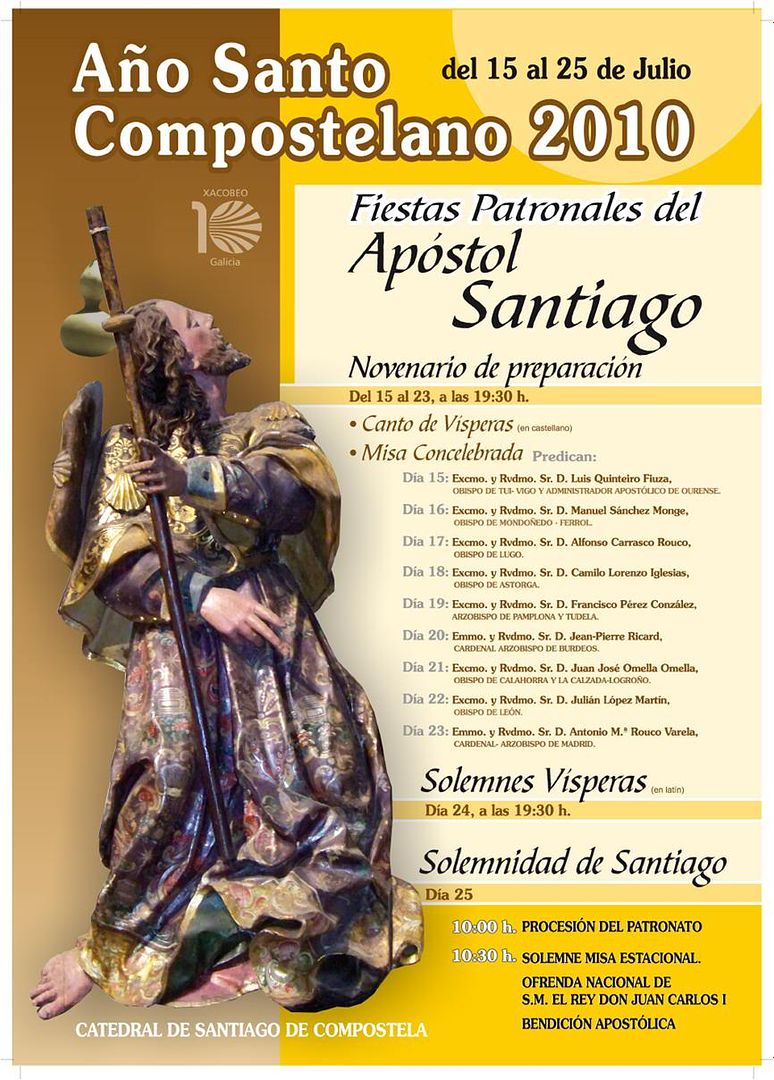
The millennial embrace of the Apostle James culminates today, July 25 - feast day of Spain's patron saint - in Galicia, northwest Spain, medieval fulcrum of evangelization for Europe and the world.
An embrace that already extends to Benedict XVI three months before his visit to Santiago de Compostela, the first visit expressly made by a Pope to venerate the saint on a Jubilee year.
Diocesan general coordinator for the Pope's apostolic visit on November 7, Mons. Salvador Domato Bua, spoke to us about the visit:
Compostela's celebration of St. James this year is remarkable both because it is a Holy Year but also because of the Pope's visit. Is this a time of spiritual renewal?
As you know, a Jubilee Year is celebrated every time that the saint's feast day falls on a Sunday, therefore, it is not a fixed observance. The next one will not come until 2021.
Traditionally, the 'Ano Santo Jacobeo' (Holy Year of St. James) was called the year of 'great pardon', even if the term is less used today. The term underscores the aspect of the observance as a close personal encounter with God as well as its penitential aspect.
One of the most obvious signs this year is the increase in the number of people going to Confession. The cathedral's chapter canons have been making sure that there are enough confessors present for longer periods in the Cathedral, who can hear confessions in different languages, and also who can give more time to each confessant.
In addition, it is always surprising to hear from the pilgrims - who these days have been streaming in like a river in flood - that what they feel on making the pilgrimage, especially those who arrive by the traditional pilgrim routes, is that they are first able to meet themselves, who they really are. And this helps them to go on and seek an encounter with the Lord in the sacraments.
The prelude to the big day today was a novena of Masses, in which each day's Mass was entrusted to a visiting bishop.
In the diocese, we have recently revived the practice of celebrating Solemn Vespers. They are very beautiful in both content and form. They are Vespers honoring the Apostle, using Biblical texts that are carefully chosen and edited. We have the participation of the cathedral choir and of an orchestra; Gregorian chant is used, the canons wear mantles from the 16th century which were given by the first Queen Isabella. Everything underscores the solemnity of the feast.
The procession of the Patronate of St. James will take place before the Mass today. The image will be borne out from the Fachada de las Platerias and re-enter the Cathedral through the main entrance facing Plaza Obradoiro.
During the Mass, the King of Spain will lead the National Offering and Prayer. Other unusual features of the Mass is the use of the Cathedral's giant swinging censer [Botafumeiro] and of
chirimias, medieval instruments
[the direct antecedent of the oboe] that are well conserved at the Cathedral.
What is the National Offering and what does it mean?
It is a practice that was instituted five centuries ago. It expresses the gratitude of the Spanish people to St. James for the protection that he has always given us, to the homeland, to the sons of Spain, from the time of the Reconquest. In the old days, it usually came with an offering of money, an artistic work or a special commemorative item for the Cathedral. Not anymore. The King - or his representative - leads an invocation to St. James.
The festivities of July 25, in effect, provide a sort of dress rehearsal for the Pope's visit...
Yes. Then there will be another test: the pilgrimage and meeting of young people (PEJ 2010) on August 5-6, when up to 15,000 young people will gather in Compostela.
And how are the young people preparing for the papal visit?
Right now, under the guidance of the diocesan officials for the pastoral care of young people, they are focused on PEJ. Our young people are aware that we need their participation, even in the papal visit.
The youth are our priority. Compostela has been a reference point for the Catholic youth of Spain and Europe since the World Youth Day was held here in 1989. Even today, after 20 years, I am always touched when, in my travels to other parts of the world, I meet persons who tell me, "I was in Compostela for World Youth Day". Even better is meeting so many priests and religious who say that being here for WYD was the final event that made them decide to consecrate their lives to the Lord.
When Benedict XVI visits on November 6, he will proceed directly to the Cathedral, pray before the tomb of St. James, cross the Holy Year Door, give the traditional embrace to an image of the saint, meet with sick persons, older people and children, and then preside at Mass in Plaza Obradoiro. He will be a pilgrim among pilgrims...
In fact, we do not refer to it simply as a trip, but as a pilgrimage. The motto we have chosen for the visit is: "Pilgrim of faith, witness to the Risen Christ".
We think it captures the sense of the Pope's pilgrimage, and what he has written, thought, and preached about Europe and its Christian roots. It brings back the famous saying that "Europe took shape in the pilgrimages to Compostela".
In fact, we are very honored that European unity took shape, in effect, along the 'Camino de Santiago' - the way of St. James - and we certainly do not wish this to be overlooked.
We are preparing for the Pope's pilgrimage very aware that, although it will only last a few hours, his presence among us will give Catholics and all persons of good will, the certainty of faith, the constancy of hope, and the courage of charity. And we expect that it will leave a very deep mark.
It will be the third papal visit to Compostela, and so our people are confident about our ability to host such an event. At the same time, one can never get used enough to close contact with the Supreme Pontiff and to the impact of his presence on Christian life among our people.
You said that the coming visit is already proving to be quite fecund. In what sense?
It's the third papal visit I have had to coordinate for the diocese. And I have the impression that public anticipation has never been greater than for this visit. In 1982, John Paul II's first visit here was an absolute novelty. The second time he came was for World Youth Day. This time, a particular joy is perceptible - as if the people need a shot of optimism and hope and they believe that they will get this from the Pope. That is my impression.
Do you anticipate any particular difficulties in the program for the Pope's visit?
Certainly, because there are always logistical problems in having a Papal Mass held in a limited space like Plaza Obradoiro. But with good will and the cooperation of the faithful, we will try to satisfy everyone. We will clear nearby areas to accommodate more Massgoers, we will set up jumbo screens, we will plan the Pope's routes so that the maximum number of people can see him. To see him in this manner is an experience that we hope to make possible for many.
Organizationally, how is the work going?
With great commitment and industry! And precisely because we do want to maximize the exposure of the Pope to the faithful. But we have to reconcile this with security considerations. As for details, I can tell you that we have already ordered 500 ciboria for the distribution of Communion at the Pope's Mass. They are enamelled vessels produced by a Galician firm.
The Pope will embrace the Apostle James and Compostela will embrace the Pope...
It will certainly be an embrace of affection, of gratitude, of joy, hope and love.
What gifts will the Archdiocese give the Pope?
We have expert goldsmiths already at work. Goldsmithery has a long and distinguished tradition in Compostela. We will also donate a sum for the Pope's charities. And of course, there will be a commemorative medallion of teh visit.
The Feast of St. James takes place a few days after the second annual meeting of the French and Spanish bishops whose dioceses are found along the 'Camino de Santiago'.
Yes. this was an initiative of our Archbishop, Mons. Julián Barrio Barrio, who almost daily, celebrates Mass for pilgrims in the Cathedral.
The meetings among the Spanish and French bishops have been an occasion fro them to reflect together on the Pope's project for the re-evangelization of Europe, which urgently needs it. It is very important because in the past, the 'Camino de Santiago' was a formidable way to evangelize Europe.
 Spanish monarchs come to Compostela
Spanish monarchs come to Compostela
to renew 'National Offering' and prayer
on the feast of St. James
Adapted and translated from
various Spanish news sources;
Photos from

July 25, 2010
 Left, King Juan Carlos delivers the Ofrenda Nacional; below eight, the giant censer (botafumeiro) in action.
Left, King Juan Carlos delivers the Ofrenda Nacional; below eight, the giant censer (botafumeiro) in action.
SANTIAGO DE COMPOSTELA - Spain's Jubilee Year of St. James culminated today in a Mass at the Cathedral of Compostela, where King Juan Carlos I led the traditional 'Ofrenda Nacional (National Offering) of the Kingdom of Spain to its patron saint.
In it, he also asked the Apostle, in the name of the Spanish people, to intercede for the unity of all Spaniards, including the autonomous regions, for help in resolving the serious economic crisis and its harsh consequences for millions of families and individuals, especially the young, and to eradicate the 'unreason of barbaric terrorists'.
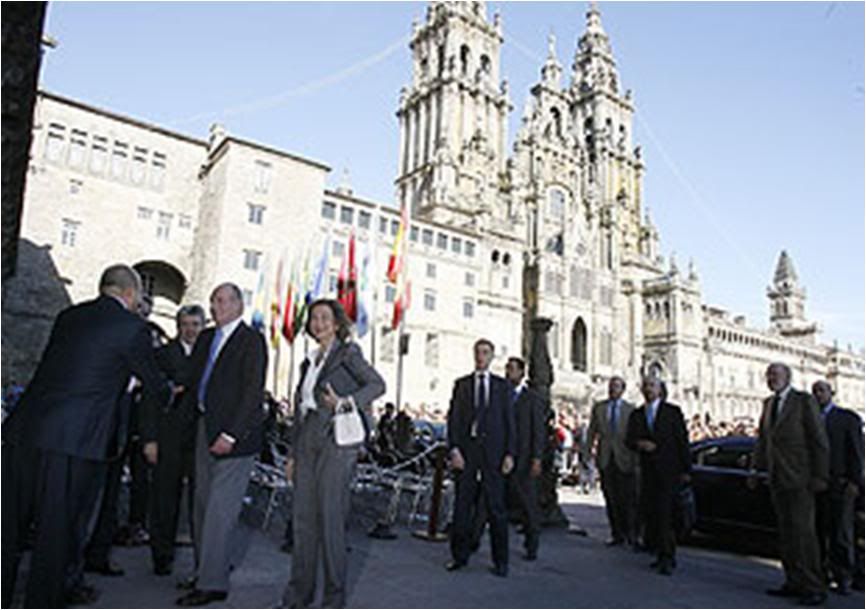 Monarchs arrive in Compostela on the eve of the feast; below, they are welcomed by Archbishop Barrios today for the Mass.
Monarchs arrive in Compostela on the eve of the feast; below, they are welcomed by Archbishop Barrios today for the Mass.

The King and his wife, Queen Sophia, arrived in Compostela last night before sundown, and what the news reports today describe as the most magnificent fireworks yet presented on Spain's religious national day.
The royal couple is expected to return to Compostela in November to welcome Pope Benedict XVI when he visits the tomb of St. James as a pilgrim during this Jubilee Year. Along with the monarchs of Belgium and Luxembourg, the Spanish Kind and Queen are the only reigning Catholic monarchs today.
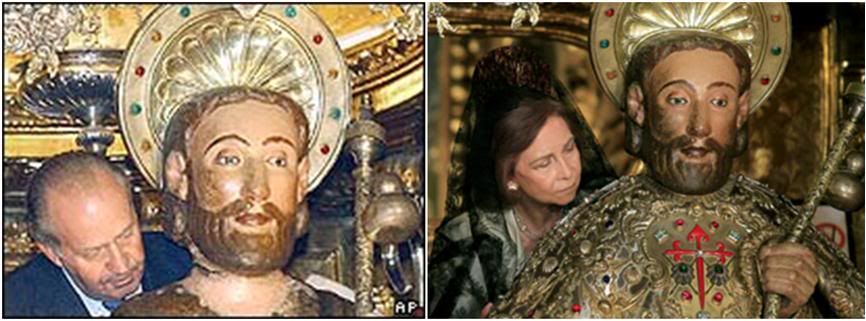 The monarchs perform the traditional 'abrazo' (embrace) of the Apostle.
The monarchs perform the traditional 'abrazo' (embrace) of the Apostle.
The King and Queen previously attended the Jacobean Jubilee Years in 1989 and 2004. The next Jubilee Year will be in 2021.
The fireworks were preceded by a state-of-the-art
son et lumiere presentation projected on the front facade of the Cathedral. A crowd of 100,000 was on hand.
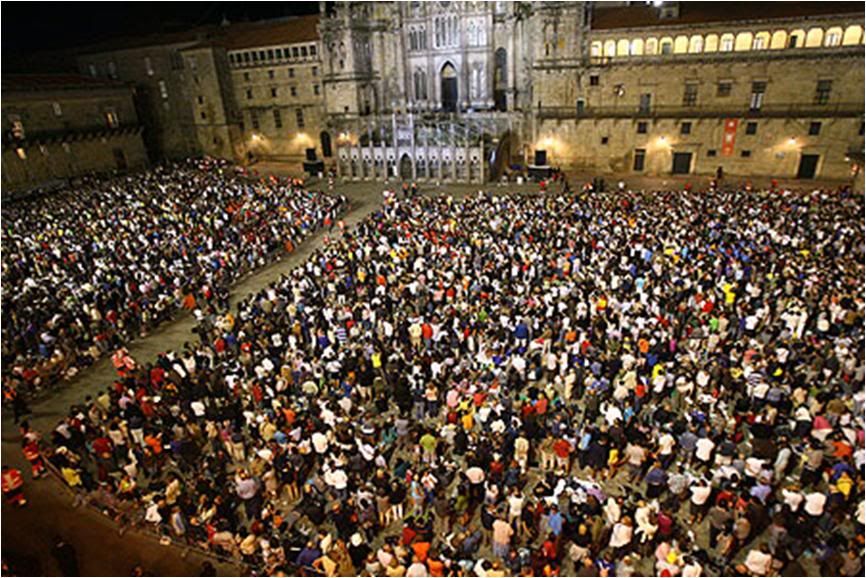
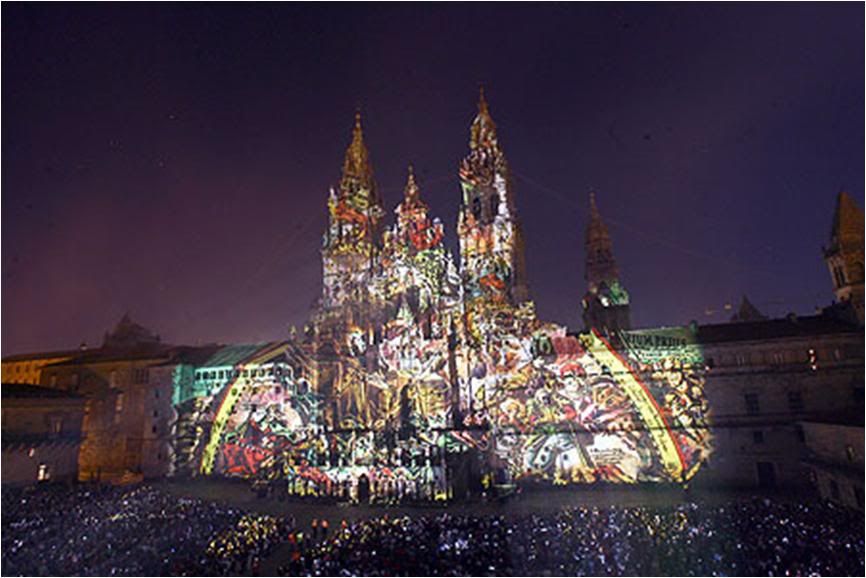
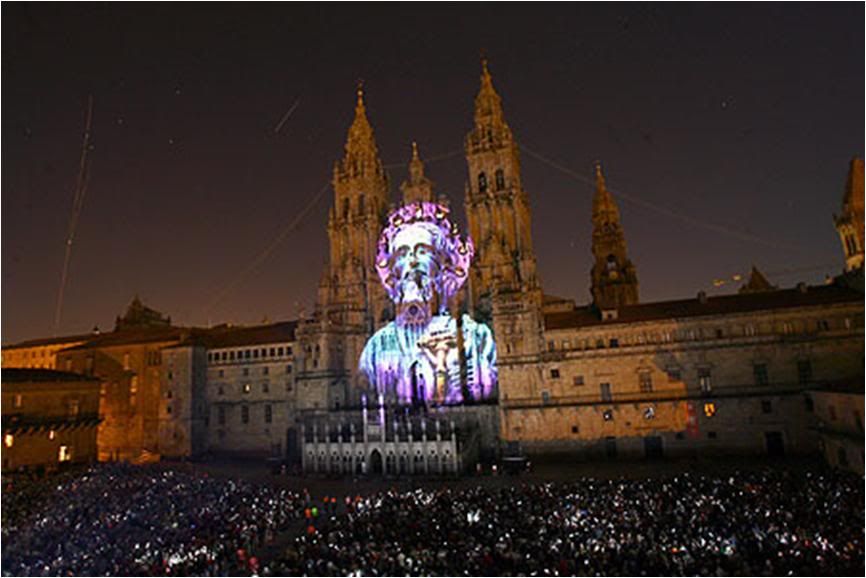
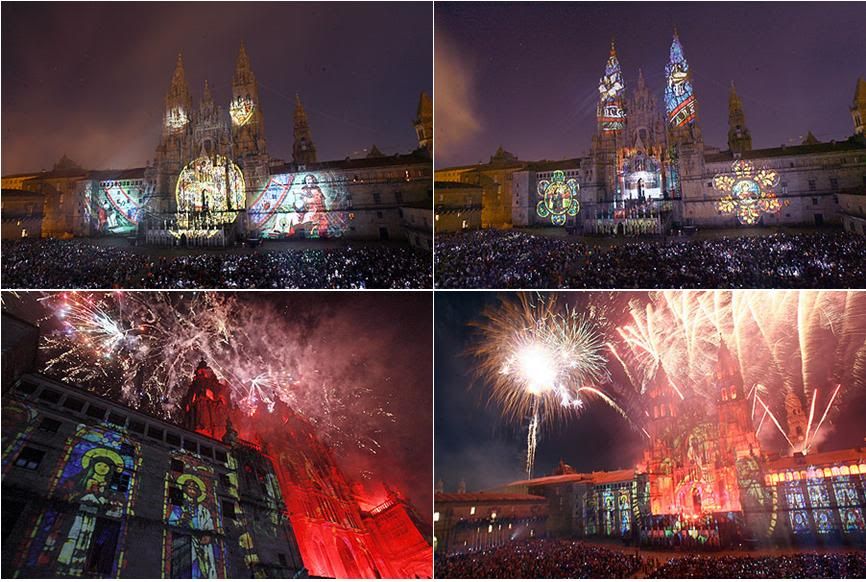

 Pilgrims flock to Compostela
Pilgrims flock to Compostela
via the Way of St.James
during Holy Year
by ELISA SANTAFE

SANTIAGO DE COMPOSTELA, July 25 (AFP) - They come from around the world to have time to think, fulfil a promise or have an adventure: the gruelling "Camino de Santiago" has seen an influx of pilgrims this year, a Holy Year, for a variety of reasons.
Joshua Fleming, a 20-year-old Austrian student, said he decided to make the pilgrimage to Santiago de Compostela in northwest Spain after reading best-selling Brazilian author Paulo Coelho's book describing his own pilgrimage in 1986.
"The challenge has opened my spirit," he said at the town of Pedrouzo at the start of the last leg of his pilgrimage, after having already walked some 300 kilometres (185 miles) across northern Spain.
The complete "Camino de Santiago" or "Way of St.James" pilgrimage route usually begins in the Pyrenees mountain range on the Spanish-French border and ends some 800 kilometres further west at Santiago's cathedral which the faithful believe holds the remains of St. James, one of Jesus's 12 Apostles.
The cathedral, which in the Middle Ages was considered the third most holy place in the Roman Catholic world after Jerusalem and Rome, has been a magnet for pilgrims for centuries.
But their numbers soar whenever July 25, the name day of St.James, falls on a Sunday as it does this year.
Last month alone over 33,000 pilgrims flocked to Santiago, compared to just under 20,000 during the same month last year, according to the archdiocese of Santiago de Compostela.
It estimates the number of pilgrims arriving in the city this year will be similar to the last Holy Year in 2004 when 180,000 people made the journey. The next Holy Year falls in 2021.
Visitors this year will include Pope Benedict XVI who is scheduled to
stop over in the city during a visit to Spain in early November.
[It is not a stopover - he is visiting Compostela expressly to make a pilgrimage to the tomb of St. James.]
Claude Champagnon, 64, and her daughter Karine, 44, from Puy-en-Velay in central France, walked the "Camino" in 2003 and are repeating it this year because it is Holy Year, when those who make the pilgrimage believe they are granted remission for their sins.
But they are unhappy to face competition for beds at the budget hostels along the route from those "who are on the 'Camino' without religious reasons".
That is the case of Jorge, Nicolas and Nacho, three 18-year-olds from Madrid, who admit they are walking part of the "Camino" to "have fun and party" by stopping in at bars and nightclubs en route.
Just over half, 55 percent, of the pilgrims who arrived in Santiago last month said they made the trip for religious reasons, five percent said they did it for cultural reasons and the rest said they were motivated by both, according to the archdiocese of Santiago.
"We prepared our trip without knowing that it was a Holy Year, but that makes it even more special," said Sonja Hahn, a 42--year-old from Germany as she waited in line for a bed at a hostel at Pedrouzo.
Her partner Klaus Becker, 56, does not share her religous motivations but is nonetheless carrying a picture of a friend who died two weeks ago in his backpack.
"It is like she is coming with me," he said.
Many who make the journey still wear the traditional garb of cape, long staff and carling felt cap adorned with scallop shells, the symbol of the saint which can be found all over the city.
In the Middle Ages pilgrims used to burn their worn out clothes after ending their journey at Cape Finistere, about 100 kilometres west of Santiago, which was then considered to be the end of the world
['finis terrae' - a cape in Galicia is in fact called 'Finisterra'.]
Some still keep up this tradition. Cesar Machado, a 46-year-old diver from Lisbon, said he was picking up plants along the way which he plans to burn along with his clothes when he finishes his pilgrimage by bicycle.
"It is the philosophy of being reborn from the ashes," he said, adding he was carrying candles from friends who are ill to light at Santiago's cathedral.
"I am fulfilling a promise that I made four years ago, it is a spiritual issue and also a search for adventure."
Pilgrims who have travelled at least 100 kilometres on foot or 200 kilometres by bicycle or on horseback can obtain the "compostela", the Latin certificate confirming they have completed a pilgrimage to the cathedral, as long as they collect stamps from hostels or churches along the way as proof.
Yoonjung Jang, a 27-year-old statistics student from South Korea, said she decided to walk the "camino" after breaking up with her boyfriend in order to "forget everything".
"Nothing has changed, but it is a very good experience", she said.
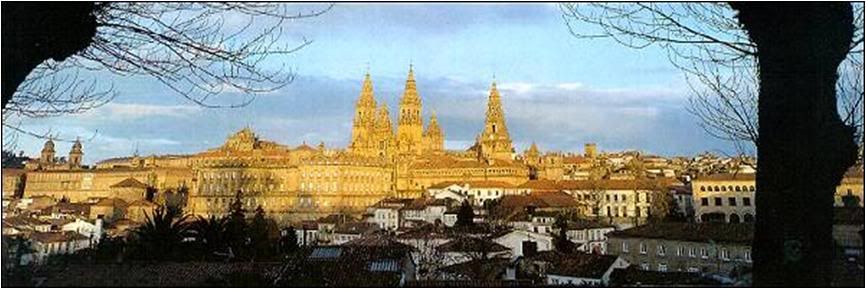
[Modificato da TERESA BENEDETTA 29/07/2010 20:08]